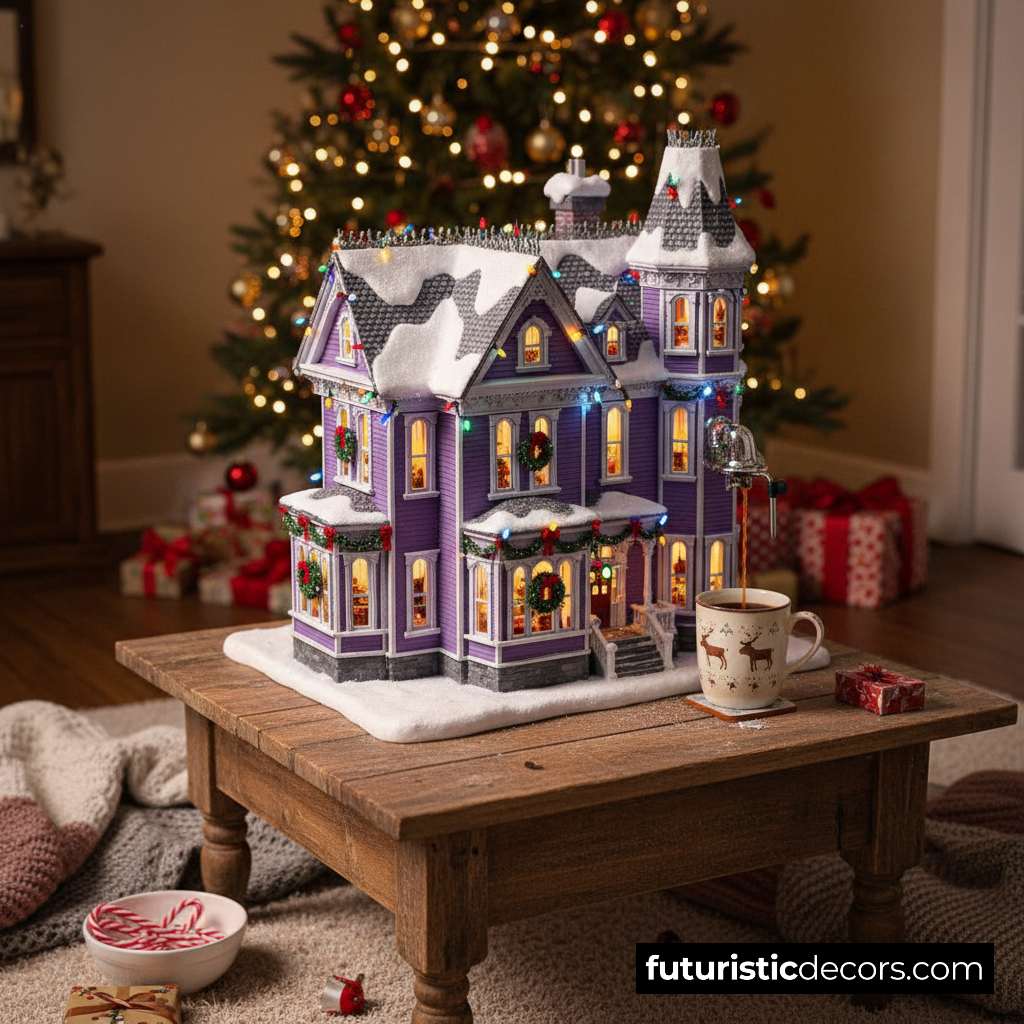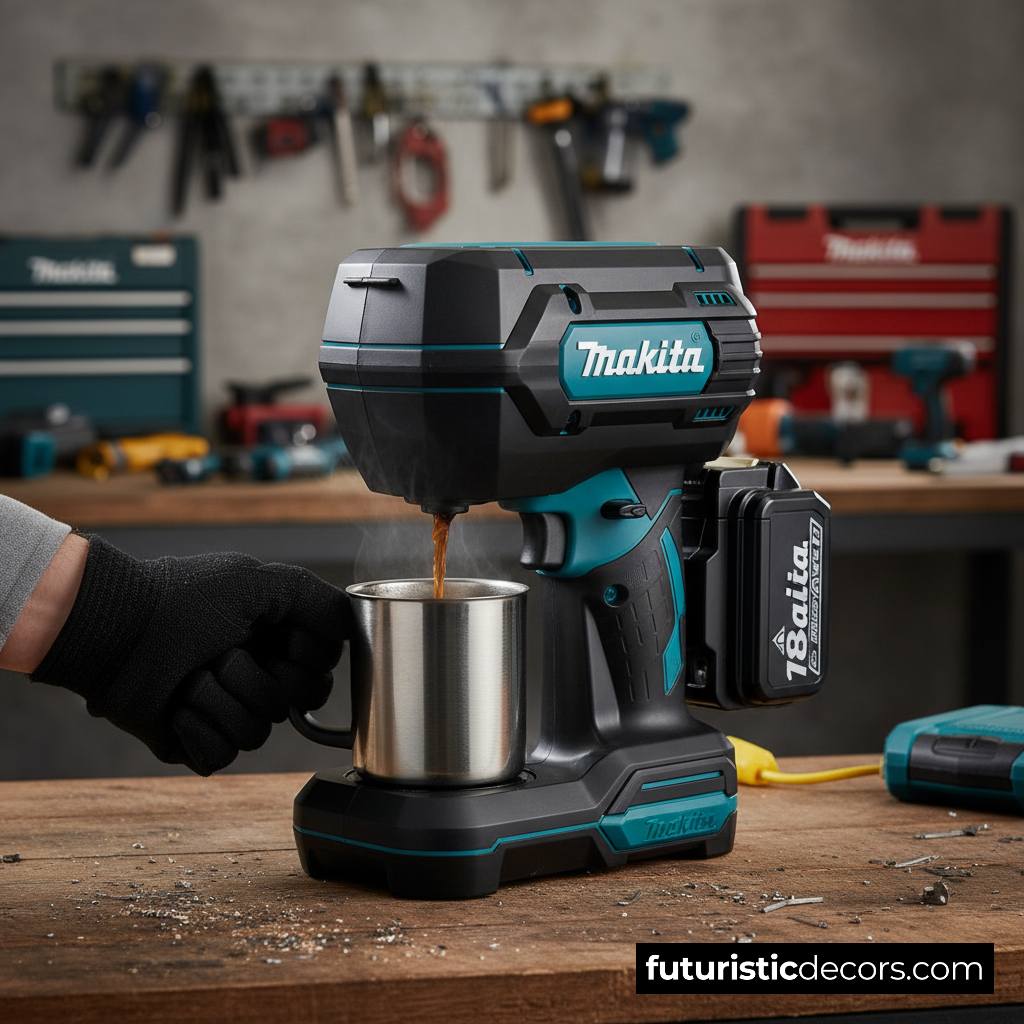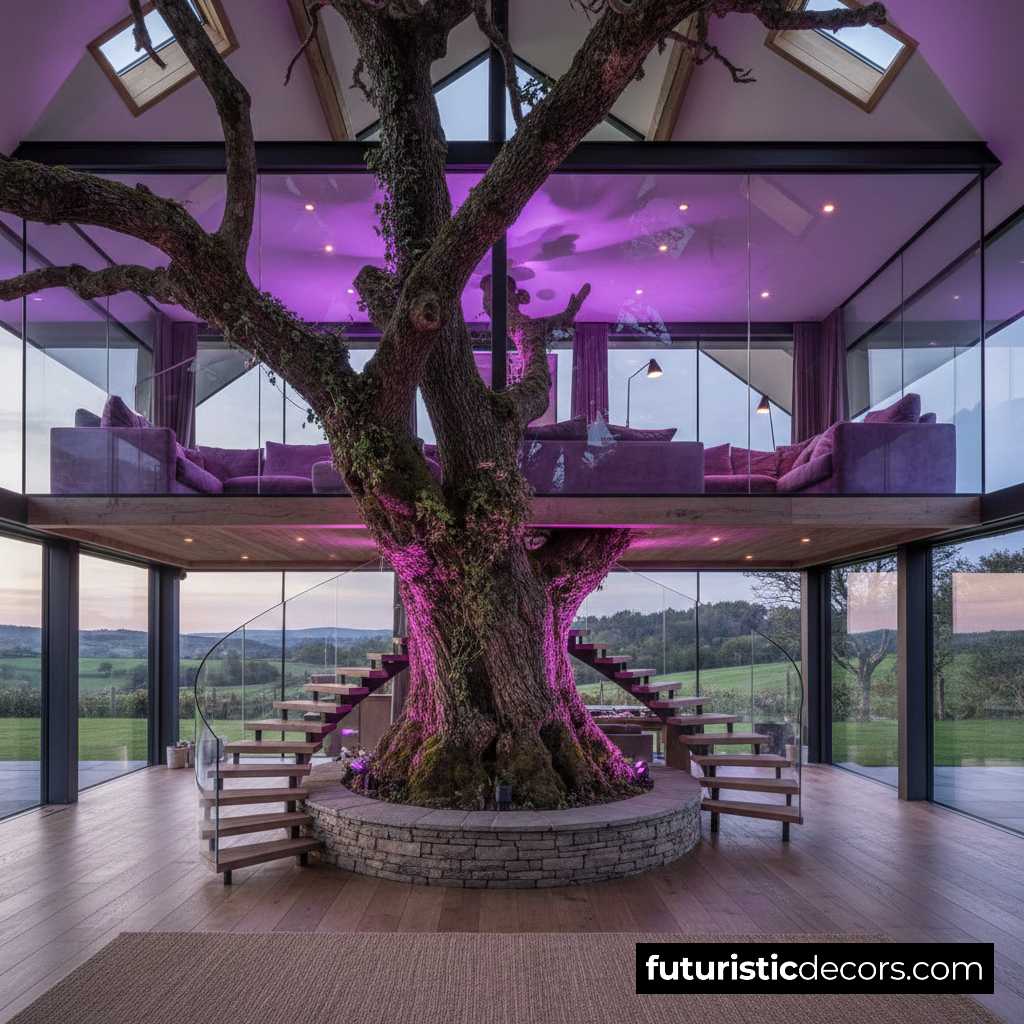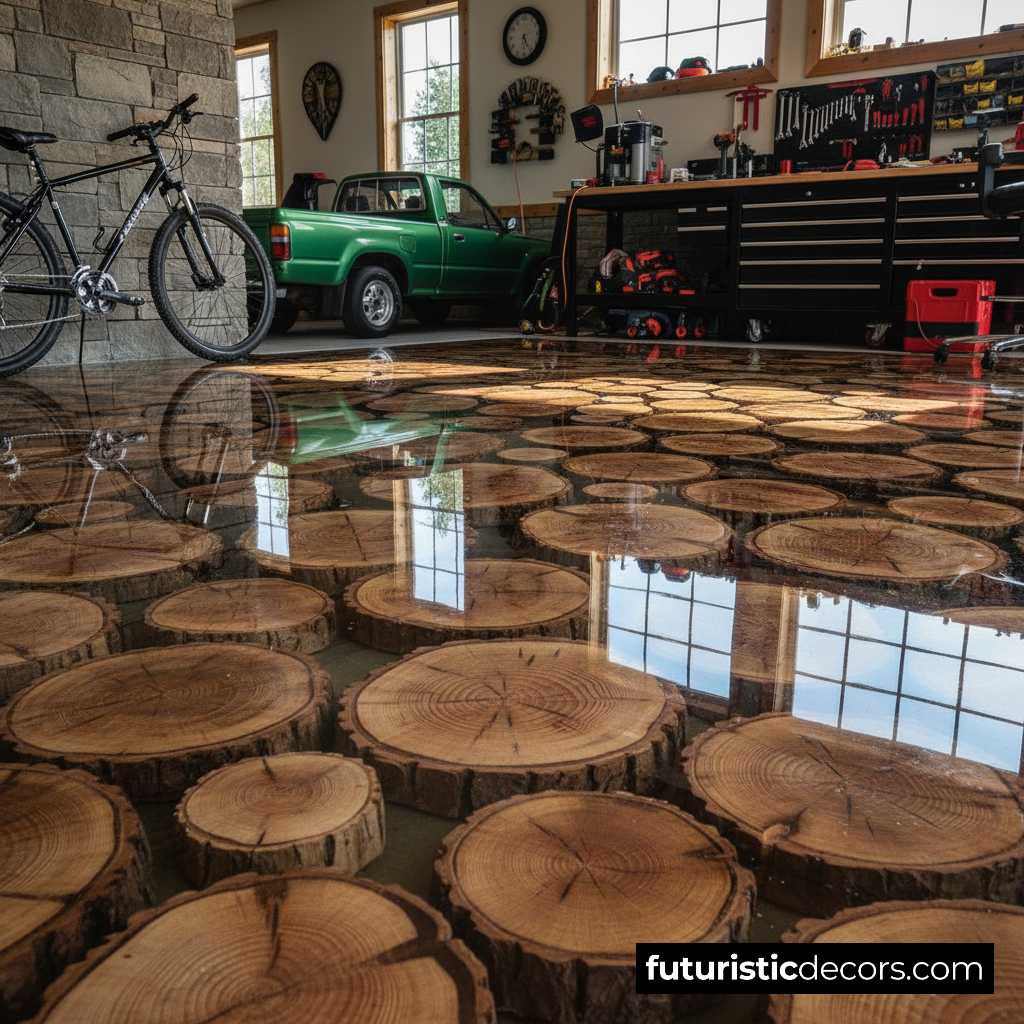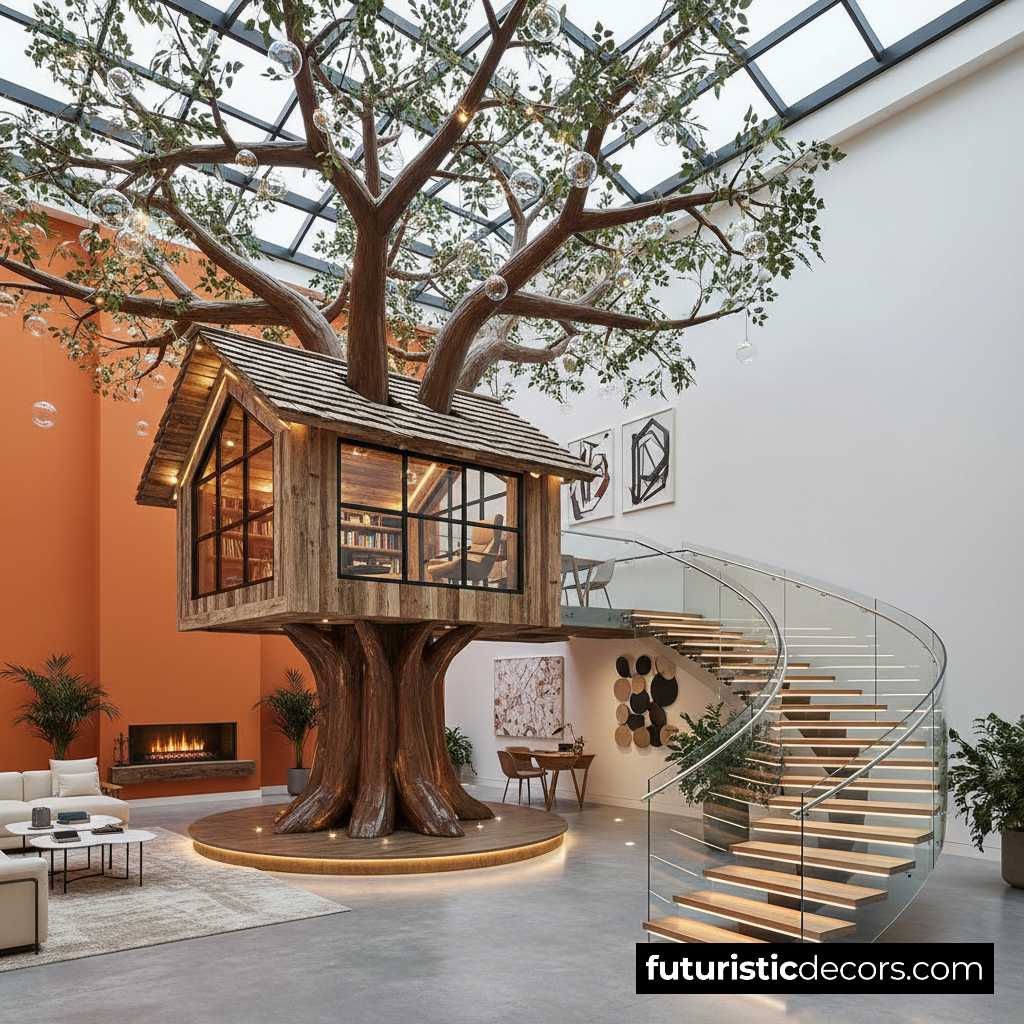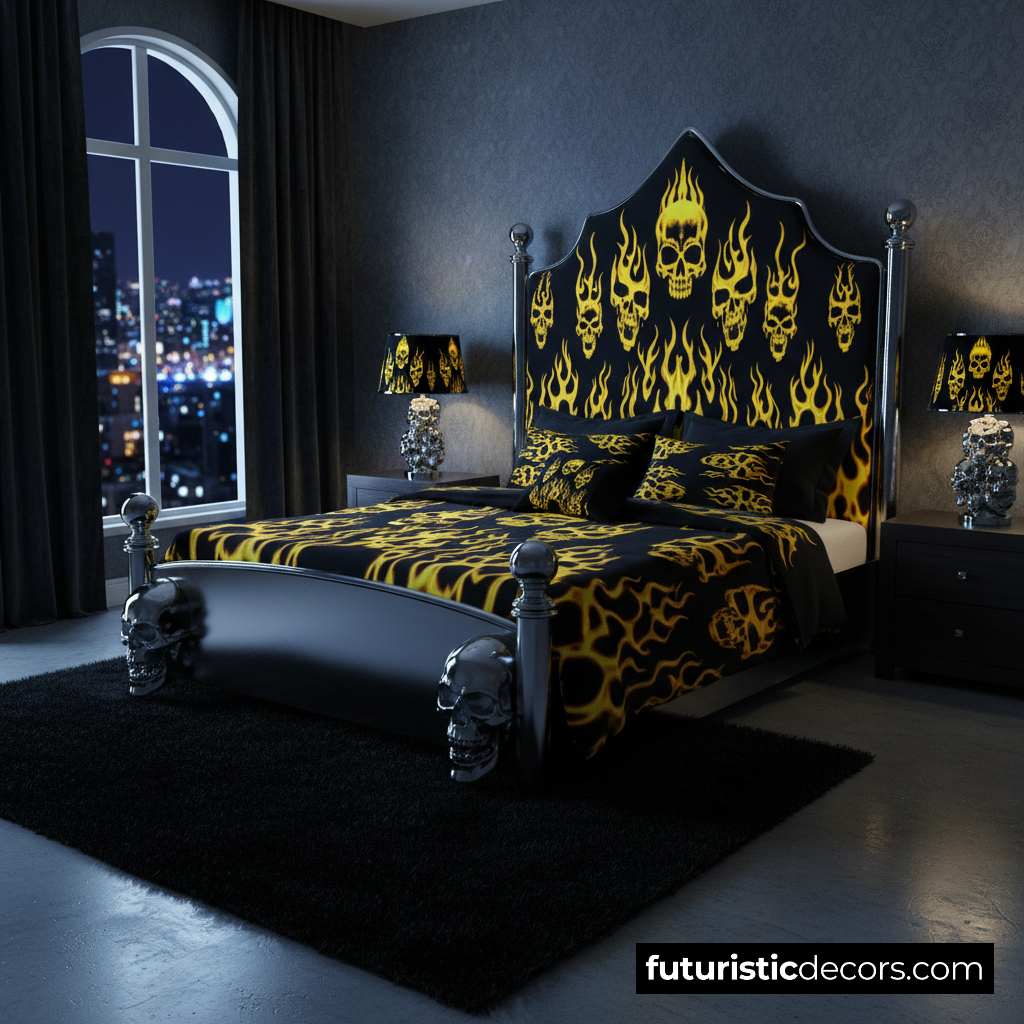Imagine stepping into a kitchen that feels like a scene from a bioluminescent forest—soft light pulses beneath smooth curves, creating an atmosphere equal parts whimsical and modern. Welcome to the world of Glowing Mushroom Kitchens, where the iconic mushroom silhouette meets cutting‑edge illumination to redefine culinary spaces. These inventive designs place a luminous mushroom‑shaped island at the heart of the room, serving both as a stunning focal point and a functional workspace. In this guide, we’ll explore everything from material choices and lighting techniques to styling accessories and practical maintenance tips, empowering you to craft your own radiant mushroom kitchen island that dazzles by day and glows by night.
The Allure of Mushrooms in Kitchen Design
Embracing Organic Shapes
Mushrooms naturally evoke feelings of whimsy and wonder, with their rounded caps and gently tapering stems. In interior design, organic forms soften the rigid lines common to cabinetry and stainless‑steel appliances, introducing a more fluid, artistic vibe. By adopting the mushroom shape for your kitchen island, you invite a sculptural element that functions as both furniture and art.

Biophilic Connection
Incorporating nature‑inspired elements—known as biophilic design—has been shown to reduce stress and enhance well‑being. A Glowing Mushroom Kitchen capitalizes on this by referencing the forest floor’s calm, earthy palette, while the integrated light source mimics the gentle glow of bioluminescent fungi. This harmonious blend of form and function brings the outdoors in, enriching your daily cooking experience.
Illuminating Design Trends: Glowing Mushroom Kitchens
LED Integration
LED technology lies at the core of any Glowing Mushroom Kitchen. Flexible LED strips installed beneath the cap’s overhang cast an even, ambient glow across countertops. High‑CRI (Color Rendering Index) LEDs ensure that produce and ingredients appear true to life, making the space both beautiful and practical.
Edge‑Lit Acrylic
Acrylic panels infused with light-diffusing particles can form the mushroom cap itself. When lit from the edges, these panels glow uniformly, eliminating hotspots and creating an ethereal halo effect. This technique pairs well with minimalist decor, letting the island’s light do the talking.
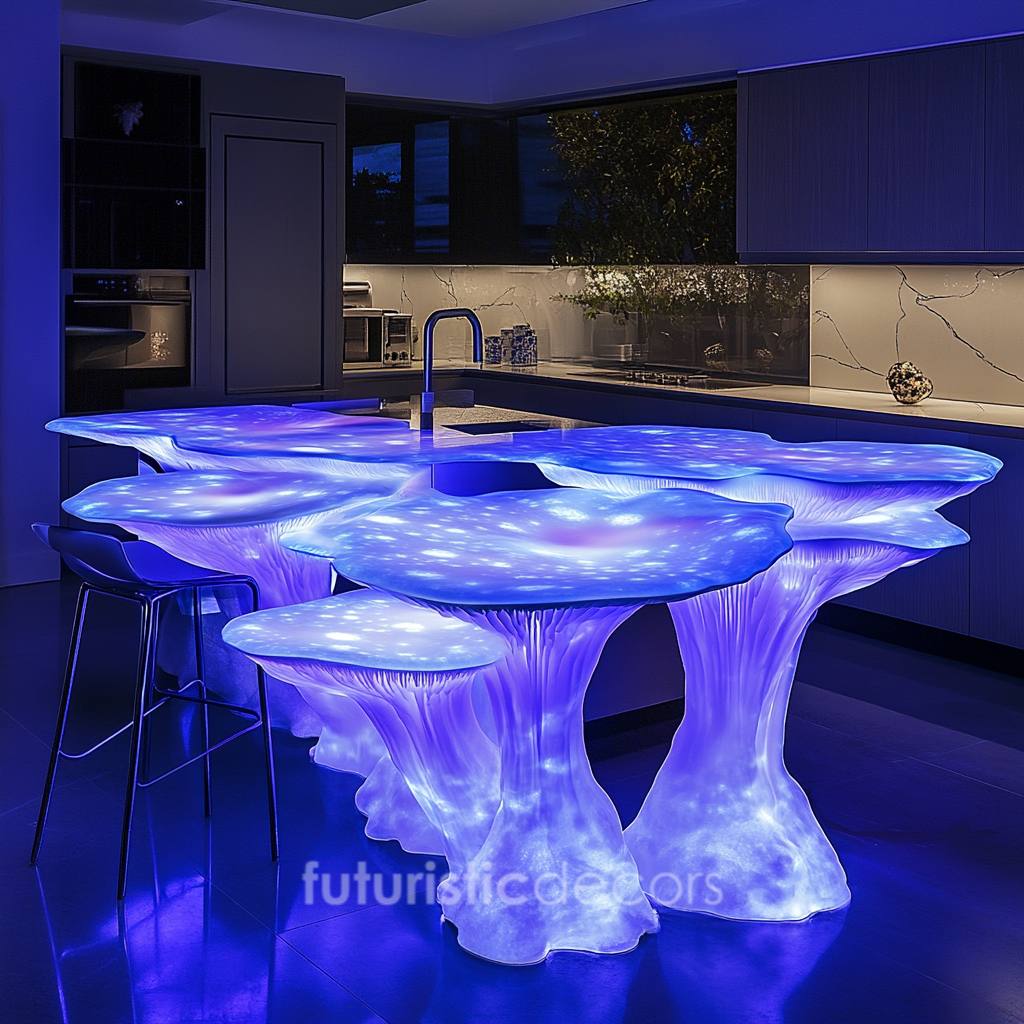
Smart Lighting Controls
Link your mushroom island’s LEDs to a smart home system for dynamic control. Adjust color temperature—from warm amber during intimate gatherings to crisp daylight for precise food prep—and set schedules so your kitchen awakens with a soft glow each morning.
Spotlight on the Mushroom Kitchen Island
Choosing the Right Scale
The success of a Glowing Mushroom Kitchen island hinges on proportion. A small apartment may call for a 4‑ to 5‑foot wide cap, while open‑plan lofts can accommodate spans of 8 feet or more. Always ensure at least 36 inches of clearance around the island for comfortable movement.
Defining the Cap and Stem
- Cap: Often a broad, circular or gently oval shape—ideally constructed from edge‑lit acrylic, tempered glass, or backlit resin.
- Stem: The support can be a sleek central column or multiple sculptural legs, finished in brushed metal or painted wood for contrast.
Multi‑Level Countertops
Consider a two‑tier design, where the illuminated cap shades both a lower prep area and a raised breakfast bar. This layered effect enhances functionality and encourages social interaction at the island.
Material and Lighting Choices: Glowing Mushroom Kitchens
Solid Surface vs. Natural Stone
- Solid Surface (e.g., Corian): Seamless and easily routed to conceal LED channels. Available in translucent colors that glow warmly when backlit.
- Quartz or Marble: Striking in appearance but opaque—pair these with under‑counter LED toe kicks for indirect glow.
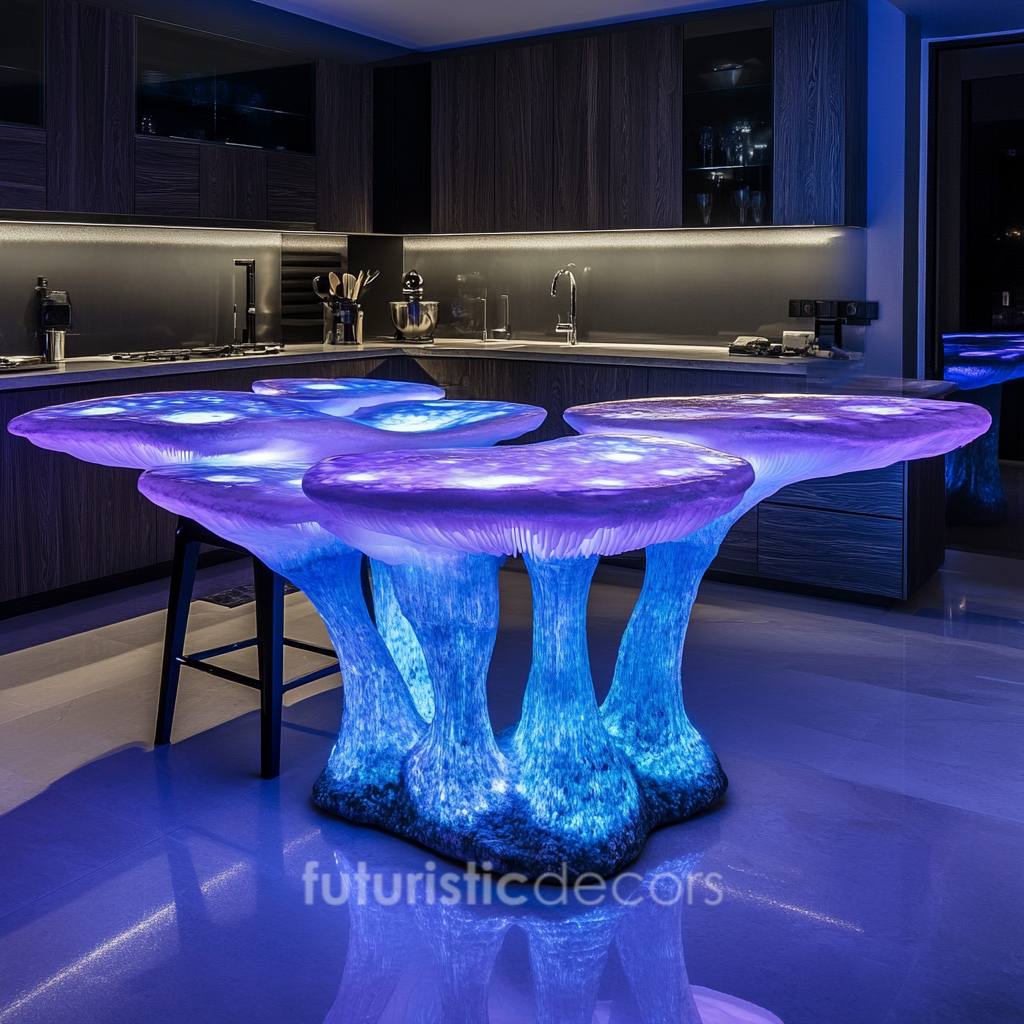
Translucent Resin
Custom pigments within poured resin create stunning, gem‑like caps. When backlit, the island appears to glow from within, highlighting swirling patterns and embedded elements such as wood inlays or decorative stones.
Hardware and Fixtures
Select hardware that complements the organic mushroom form—rounded pulls, curved faucet spouts, and soft‑edged sink basins maintain visual continuity. For a cohesive look, consider brushed brass or matte black finishes.
Color Palettes and Textures: Glowing Mushroom Kitchen
Earthy Neutrals with Pops of Color
Begin with a base palette of warm neutrals—taupe, mushroom gray, and sandy beige—to ground the design. Introduce accents of forest green or deep burgundy in cabinetry or barstool upholstery to echo natural fungi hues.
Monochromatic Glow
For a truly futuristic take on a Glowing Mushroom Kitchen, opt for a single translucent hue—icy blue or soft lavender—throughout the cap. Complement with matte white or pale gray cabinets for a dreamy, cohesive atmosphere.
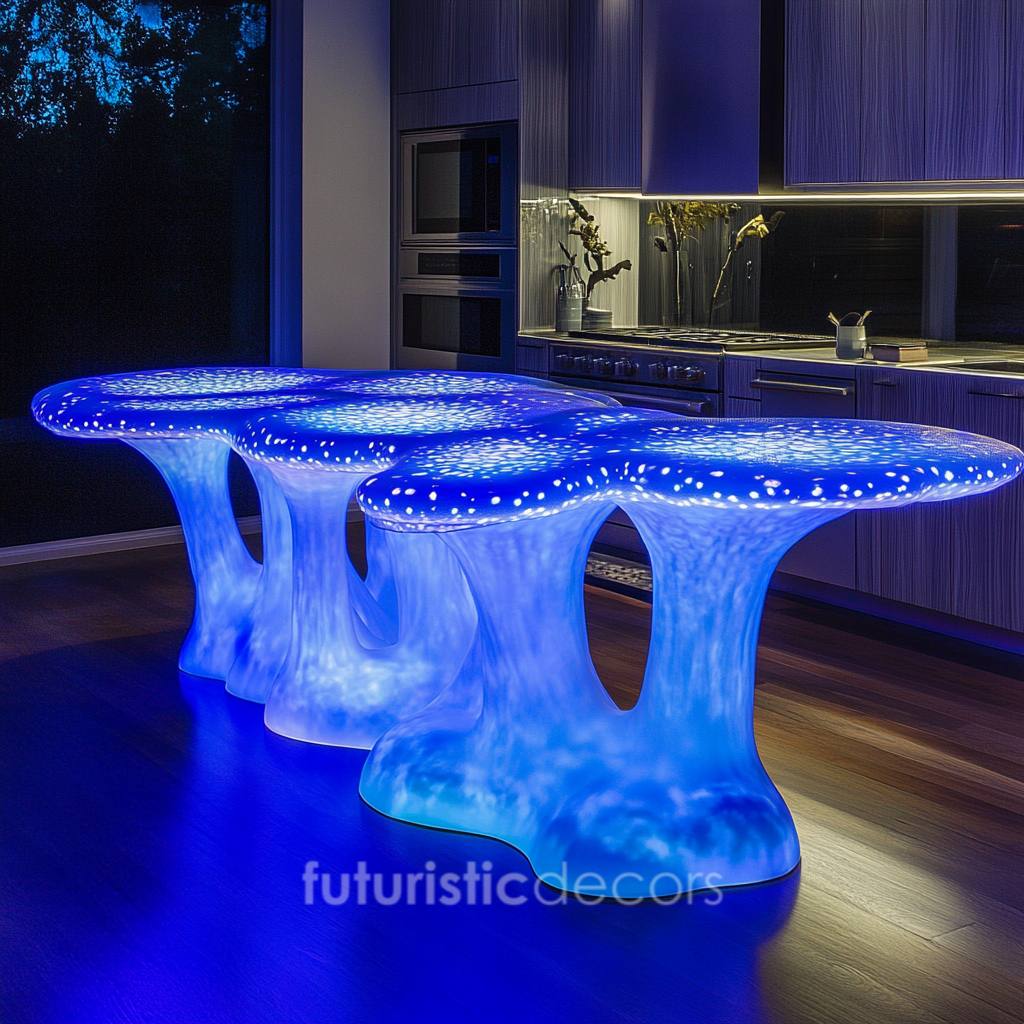
Textural Contrasts
Pair the island’s smooth, luminous cap with textured elements elsewhere: hand‑finished wood butcher block, fluted tile backsplash, or woven pendant lamp shades lend depth and tactile interest.
Styling Accessories for a Radiant Vibe
Statement Seating
Choose counter stools with rounded backs and plush upholstery to mirror the mushroom cap’s curves. Upholstery in velvet or boucle fabrics adds a luxurious touch, while metal legs in bronze or copper coordinate with ambient lighting.
Illuminated Display Shelves
Install slim floating shelves on an adjacent wall, backlit with warm LED tape. Showcase cookbooks, ceramics, or mushroom‑themed décor pieces for visual continuity and an extra layer of illumination.
Botanical Accents
Group potted plants with varying leaf shapes—ferns, pothos, and small succulents—to reinforce the biophilic theme. A terrarium featuring moss and miniature fungus replicas can serve as a playful centerpiece.
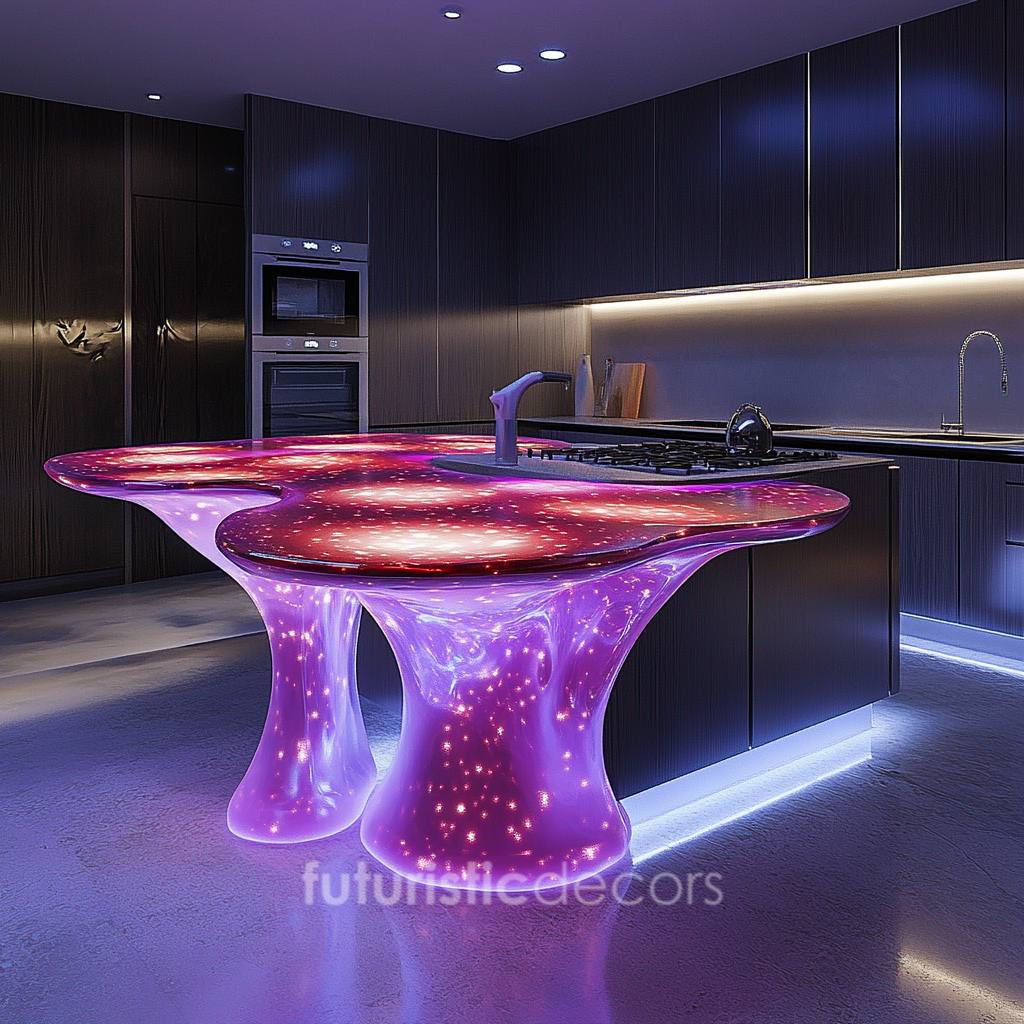
Integrating with Overall Kitchen Design: Glowing Mushroom Kitchens
Cabinetry and Storage
Opt for handle‑less cabinets with push‑to‑open mechanisms to maintain the kitchen’s smooth lines. Hidden storage solutions—pull‑out pantries, appliance garages—keep surfaces uncluttered, allowing your glowing island to command attention.
Complementary Lighting Layers
Layer general, task, and accent lighting to support the island’s glow. Recessed ceiling lights provide even illumination, under‑cabinet strips illuminate countertops, and pendants over adjacent areas add decorative flair.
Flooring and Backsplash Choices
Neutral porcelain tile or wide‑plank oak floors create a serene foundation. For the backsplash, consider a subtle metallic sheen or iridescent glass mosaic that catches and reflects the island’s light, enhancing the overall luminosity.
Functional Considerations: Glowing Mushroom Kitchens
Heat Management
LEDs generate minimal heat, but integrating cookware and sink within the island requires proper ventilation. Install downdraft vents or a sculptural overhead hood that complements the mushroom motif without obstructing views.
Cleaning and Durability
Choose non‑porous surfaces for easy wiping—especially important where the light source may accentuate fingerprints or smudges. Tempered glass and sealed resin resist stains and discoloration over time.
Electrical and Wiring
Plan electrical circuits early in the renovation. Conceal power supplies and drivers within the island’s stem or in-person drawers. Employ waterproof connectors if integrating into sink islands.
Personalization Tips: Glowing Mushroom Kitchens
Custom Cap Patterns
Work with artisans to embed patterns—vine tendrils, abstract swirls, or sogar laser‑etched mushroom gills—within your translucent cap. When lit, these designs cast intricate shadows and add character.
Color‑Changing LEDs
Opt for RGBW (red, green, blue, white) LED modules to shift between pure white task light and vibrant accent hues. Use a dedicated app or wall control panel to program scenes: “Cozy Glow,” “Party Mode,” or “Morning Fresh.”
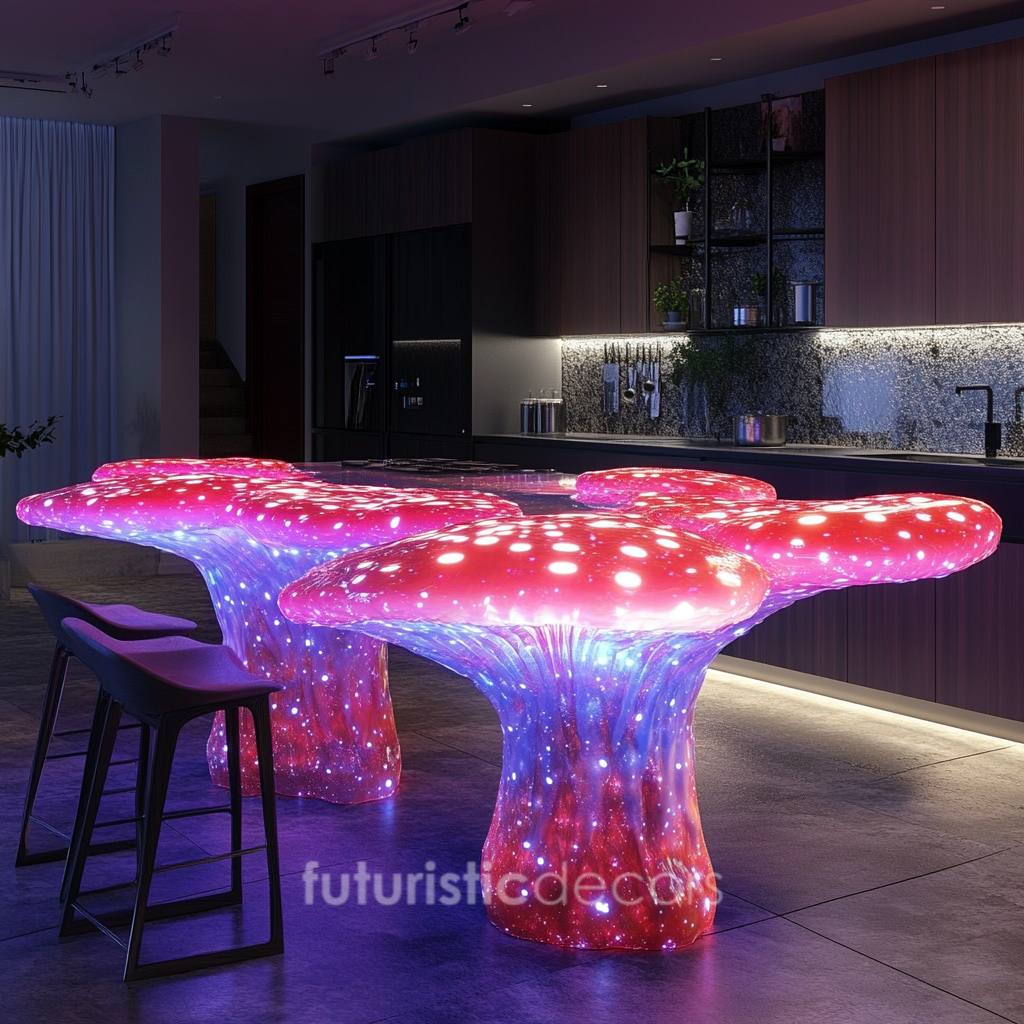
Integrated Technology
Incorporate wireless charging pads into the countertop, Bluetooth speakers into the island’s stem, or even a small touchscreen control panel. These discreet features elevate functionality without distracting from the organic form.
Maintenance and Care
- Daily Wipe‑Down: Use a microfiber cloth and mild, non‑abrasive cleaner to maintain streak‑free shine on acrylic or resin surfaces.
- Monthly LED Inspection: Check that light strips are secure and drivers are functioning. Replace any dimming modules promptly to prevent uneven illumination.
- Annual Sealant Renewal: For porous natural stones or wood accents, reseal surfaces once a year to guard against moisture intrusion.
Case Studies: Real‑World Inspirations
The Urban Loft in Seattle
An open‑plan loft features a 6‑foot diameter cap cast in pale green resin, suspended over a central prep area. Underneath, integrated drawers reveal hidden knife blocks and charging stations. At night, the island bathes the polished concrete floor in a soothing emerald glow, making it both sculpture and hub.
Scandinavian‑Style Retreat in Copenhagen
Here, a minimalist white acrylic cap with subtle wood grain textures rests on a birch‑veneered stem. Smart warm‑white LEDs sync with sunrise and sunset times, gently waking early risers and signaling evening wind‑down. Crisp white cabinets and matte black fixtures complete the serene, hygge‑inspired look.
Frequently Asked Questions: Glowing Mushroom Kitchens
1. What materials work best for a glowing mushroom kitchen island?
For a seamless glow effect, edge‑lit acrylic and translucent resin are top choices. Acrylic panels routed with LED channels yield uniform illumination, while custom‑poured resin can incorporate pigments, inclusions, or organic textures. Both materials are non‑porous and easy to clean, making them ideal for Glowing Mushroom Kitchens.
2. Can I install a glowing mushroom island myself?
Enthusiastic DIYers can assemble modular LED and acrylic kits, especially for smaller islands under 5 ft. However, any project involving built‑in electrical wiring, load‑bearing supports, or integrated plumbing is best handled by professionals to ensure safety, code compliance, and flawless finishes.
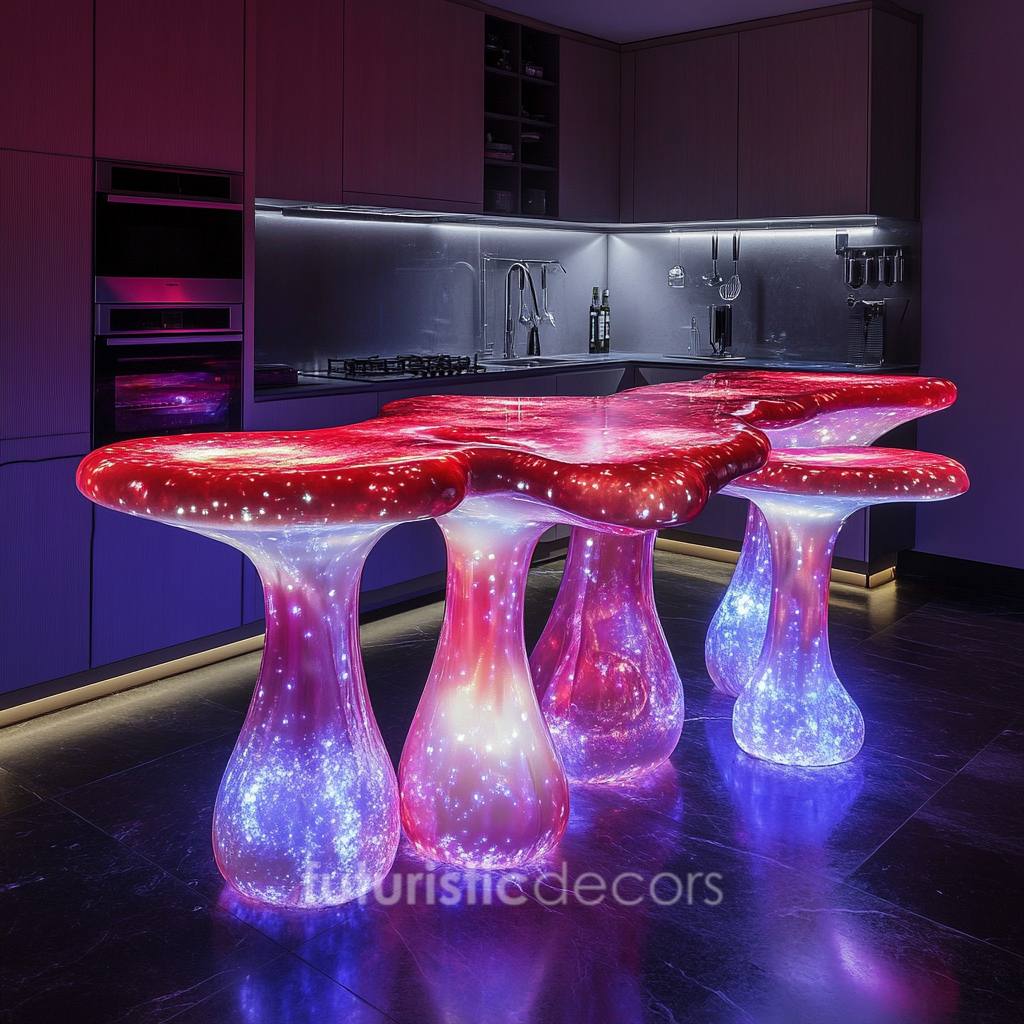
3. How much does a glowing mushroom kitchen island cost?
- Entry‑level kits (pre‑fabricated cap + plug‑and‑play LEDs): $2,500–$4,000
- Mid‑range custom installs (poured resin or bespoke acrylic + smart controls): $8,000–$12,000
- High‑end bespoke designs (artisan details, embedded accents, full home integration): $15,000–$25,000+
Factor in labor (15–25% of material costs) and any structural or permit expenses when budgeting your Glowing Mushroom Kitchen.
4. How do I maintain and clean the illuminated surfaces?
Wipe down acrylic or resin caps daily with a microfiber cloth and mild, non‑abrasive cleaner. Avoid abrasive pads or harsh solvents that can scratch the surface. Annually inspect LED modules for secure connections and replace any dimming strips promptly to maintain even glow.
5. What lighting control options are available?
Most installations use RGBW LED strips paired with a smart controller. You can:
- Adjust color temperature (warm to cool whites)
- Select accent colors (emerald, violet, or soft pastels)
- Program timed scenes (morning glow, evening unwind, party mode)
Integration with popular smart home systems (e.g., Philips Hue, Lutron, or HomeKit) makes managing your glow effortless.
6. Is it possible to change the glow color in my mushroom island?
Yes—by specifying RGBW LEDs, you gain full-spectrum color control. Use an app or wall panel to dial in any hue, from soft ambers for a cozy vibe to vibrant blues and purples for a dramatic effect that enhances your Glowing Mushroom Kitchens ambiance.
7. How do I choose the right size for my mushroom island?
Measure available floor space, allowing at least 36 inches of clearance on all sides. Smaller kitchens suit 4–5 ft diameters, while open‑plan layouts can handle caps up to 8 ft. Always consider workflow zones—prep, cooking, and seating—when finalizing dimensions.
8. Can I integrate appliances into my glowing mushroom island?
Absolutely. Common integrations include:
- Undermount sinks with illuminated toe kicks
- Induction cooktops with backlit controls
- Downdraft vents that emerge from the cap’s stem
Ensure proper ventilation and waterproofing by collaborating with experienced fabricators aware of Glowing Mushroom Kitchens requirements.
9. What design styles complement a glowing mushroom island?
- Scandinavian Minimalism: White acrylic cap, light wood stem, and crisp black accents for a hygge‑inspired kitchen.
- Biophilic Modern: Earthy stone floors, fluted tile backsplash, and lush greenery to highlight the organic form.
- Futuristic Luxe: Translucent resin in jewel tones, velvet‑upholstered stools, and metallic fixtures for a glam statement.
10. Are glowing mushroom islands environmentally friendly?
Many LED systems boast high energy efficiency and long lifespans (50,000 + hours). For eco‑minded builds, choose low‑VOC resins, recycled acrylic, and OLED panels when available. Smart scheduling features also reduce unnecessary power use, aligning your design with sustainable practices in Glowing Mushroom Kitchens.
DIY vs. Professional Installation
| Aspect | DIY Approach | Professional Installation |
|---|---|---|
| Cost | Lower material-only expenses; no labor fees | Higher overall cost but includes expertise |
| Complexity | Challenging routing channels and wiring | Experts handle electrical and structural work |
| Customization | Limited to off‑the‑shelf kits | Fully bespoke shapes, materials, and tech |
| Warranty & Support | No formal warranties | Service guarantees on lighting and structure |
For most homeowners, collaborating with a specialist ensures safe electrical integration and flawless finishes, though enthusiastic DIYers may tackle smaller accent islands with modular edge‑lit panels.

Budgeting and Cost Considerations
- Entry‑Level Kits: Modular cap-and-stem kits with plug‑and‑play LEDs start around $2,500–$4,000.
- Mid‑Range Custom Builds: Tailored resin or acrylic caps, integrated storage, and smart controls range from $8,000–$12,000.
- High‑End Bespoke Installations: Artisan‑crafted resin pours, embedded accents, premium cabinetry, and whole‑home lighting integration can exceed $20,000.
Factor in installation labor (15–25% of material costs), permit fees, and any required structural modifications. Staging your project in phases—lighting first, then surfacing, then tech—can help spread expenses.
Embracing Biophilic Benefits
Beyond aesthetics, the presence of soft, organic forms and gentle light supports mental well‑being. Studies show that biophilic interiors can lower blood pressure, improve focus, and elevate mood. A Glowing Mushroom Kitchen not only delights the senses but also fosters a healthier, more restorative environment—transforming meal prep into a mindful ritual.
Future Trends in Glowing Mushroom Kitchens
- Sustainable Illumination: OLED panels, with their ultra-thin profiles and even light distribution, represent the next frontier. Future caps may employ biodegradable composites infused with organic LEDs for truly eco‑friendly glow.
- Adaptive Lighting: Advances in circadian‑rhythm lighting will allow kitchen illumination to adjust gradually throughout the day, syncing with your body’s natural clock.
- Augmented Reality Overlays: Imagine donning AR glasses that project recipe instructions onto your glowing island’s surface, blending digital convenience with physical artistry.
Conclusion
A Glowing Mushroom Kitchen island transcends conventional design, merging sculptural artistry with innovative lighting to create a focal point that’s as functional as it is enchanting. By thoughtfully selecting materials, playing with color and texture, and integrating smart controls, you can craft a radiant mushroom island that anchors your kitchen in both style and utility. Whether you embrace a DIY approach or partner with experienced artisans, the end result promises to wow friends, delight family, and transform everyday cooking into a luminous, immersive experience.



